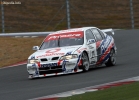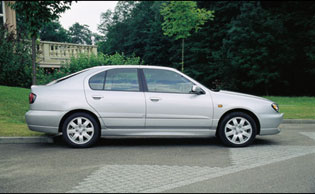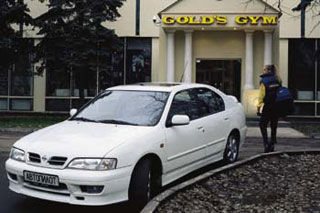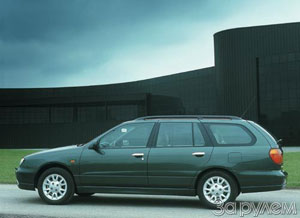Test drive Nissan Primera sedan 1996 - 1999 sedan
Twins?
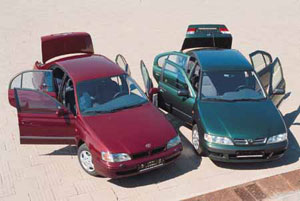 We somehow scrape the magazine hem in the current year and marveled a lot. Some problems with the horizons of our correspondents. When looking to the west, everything is fine: most of the European car manufacturers were honored, they paid enough space to the Americans, even remembered the Brazilian cars. As regards the eastern neighbors, the impression is that the geography ends in South Korea. Excluding the headings of companies and reviews, we have almost forgotten about a huge number of Japanese cars, new and not so that filled car dealerships in recent months.
We somehow scrape the magazine hem in the current year and marveled a lot. Some problems with the horizons of our correspondents. When looking to the west, everything is fine: most of the European car manufacturers were honored, they paid enough space to the Americans, even remembered the Brazilian cars. As regards the eastern neighbors, the impression is that the geography ends in South Korea. Excluding the headings of companies and reviews, we have almost forgotten about a huge number of Japanese cars, new and not so that filled car dealerships in recent months. True, at the beginning of the year, two Toyota SUVs and a brief overview of Mazda models were presented, but this is a drop in the sea against the background of the extensive sector of the Russian market engaged in Japanese products. We hasten to make up for the gap and bring to your attention two cars from the giants of the Japanese auto industry - Toyota Carina and Nissan Primera. These cars are well known to consumers, have proven themselves in operation and are in stable demand.
For comparative tests, we always try to choose approximately the same cars. It turns out not always - then the power of the engines do not coincide, then the equipment differs, then something else is wrong. There were no problems with Toyota Carina and Nissan Primera, even the configuration of both machines were identical. Both have an electric package and a full audio quote without a radio, air conditioning, a pillow for the driver and a very similar set of control devices.
 Externally, the machines also differ little, especially in the FAS. If you remove the branded nameplate from the hoods, then when you look at the front, the non -specialist is unlikely to determine which car is in front of him. The same headlights, the same bumpers, sprouted gratings of radiators, even V-shaped stamping on the hood are identical, scattering from the center to external mirrors. When examining the profile, there is also a significant similarity, excluding, perhaps, the ends of the trunk. In Carina, it is rounded, in the general style of a machine without sharp corners, and in Primera - an upturned one, imitating a small anti -wing.
Externally, the machines also differ little, especially in the FAS. If you remove the branded nameplate from the hoods, then when you look at the front, the non -specialist is unlikely to determine which car is in front of him. The same headlights, the same bumpers, sprouted gratings of radiators, even V-shaped stamping on the hood are identical, scattering from the center to external mirrors. When examining the profile, there is also a significant similarity, excluding, perhaps, the ends of the trunk. In Carina, it is rounded, in the general style of a machine without sharp corners, and in Primera - an upturned one, imitating a small anti -wing. The biggest difference in the exterior of cars is behind. It is difficult to confuse the high and rounded Carina stern with something, and the designers' rear panel seemed to be torn off the BMW treshka.
 We started acquaintance with cars with Toyota Carina, as with a longer genealogy. The first car bearing this name made his debut 40 years ago. He was subjected to numerous alterations, modifications and improvements in accordance with the spirit of time, technical progress and fashion, and the 1997 model has nothing to do with the 1957 model except purpose.
We started acquaintance with cars with Toyota Carina, as with a longer genealogy. The first car bearing this name made his debut 40 years ago. He was subjected to numerous alterations, modifications and improvements in accordance with the spirit of time, technical progress and fashion, and the 1997 model has nothing to do with the 1957 model except purpose.  Carina has always belonged to the top of a small class (according to European terminology - to family cars). The car was never insanely advanced or revolutionary, the creators did not have hopes for it for a coup in the auto industry and did not seek to conquer high -profile titles. But Carina has always been a solid and inexpensive mass machine and, by the number of sales, can safely claim one of the first places in the world.
Carina has always belonged to the top of a small class (according to European terminology - to family cars). The car was never insanely advanced or revolutionary, the creators did not have hopes for it for a coup in the auto industry and did not seek to conquer high -profile titles. But Carina has always been a solid and inexpensive mass machine and, by the number of sales, can safely claim one of the first places in the world. The last restyling was carried out in 1992, but now the car looks quite modern. Last year, he received a new grille of the radiator. It is impossible to determine the origin of the car along the lines of the body, it is standard-international, intended for a wide variety of markets and designed to satisfy the tastes of a not too rich and practical buyer.
 The car for a car of this class is very spacious. All governing bodies are easily available, are exactly where they should be. A certain dissonance in the beautiful ergonomics as a whole is introduced absurdly located the windows control buttons on the right front door. They are strengthened in the end of the plastic beam sticking out of the cladding. It would be much more logical to unite it with an armrest pen, just as it is done on the left side.
The car for a car of this class is very spacious. All governing bodies are easily available, are exactly where they should be. A certain dissonance in the beautiful ergonomics as a whole is introduced absurdly located the windows control buttons on the right front door. They are strengthened in the end of the plastic beam sticking out of the cladding. It would be much more logical to unite it with an armrest pen, just as it is done on the left side. The driver's seat is equipped with all standard adjustments (plus heating and a variable tilt of the seat pillow). Thanks to this, a person of any growth can accommodate in it with maximum comfort. The optimal landing for the driver is reclining. The steering column adjustable in height allows you not to stretch their hands, therefore, they will not get tired even with a long trip. External and internal mirrors are located very well; Despite the significant height of the back of the car, the review through them is excellent.
 Primera does not have such a long story as Carina. The first generation appeared in 1990, the second in 1996. We will refer to Motor 7 to familiarity with this car in more detail, where the story of our correspondent about the PRIMERA test drive on the roads of Europe is published.
Primera does not have such a long story as Carina. The first generation appeared in 1990, the second in 1996. We will refer to Motor 7 to familiarity with this car in more detail, where the story of our correspondent about the PRIMERA test drive on the roads of Europe is published.  Everything that was said about the interior and exterior of Carina can be repeated almost literally for Primera, with the exception of the dimensions of the salon - with exactly the same external size of two vehicles, the rear passengers in Primera will be noticeably more closely.
Everything that was said about the interior and exterior of Carina can be repeated almost literally for Primera, with the exception of the dimensions of the salon - with exactly the same external size of two vehicles, the rear passengers in Primera will be noticeably more closely. It would seem strange. Carina is an international car, designed for both the USA and Europe, and for Japan, where people are still smaller. Primera - the car is purely European, and the places in the rear seat are smaller. Perhaps the fact is that Carina is a typically family car. And from the very beginning, Primera was created as a car for active European drivers who travel faster and more aggressive than anywhere in the world. Such a manner of movement usually does not imply a complete load of the car by passengers, therefore, the seats behind can be made more doub.
 The most significant differences in the Carina and Primera salons can be observed in the execution of the cladding of internal panels. On Carina, all plastic details look very solid and solid, but slippery and hard to the plastic touch. In Primera, on the contrary, at first glance, the coating at first glance when touching is warm and elastic.
The most significant differences in the Carina and Primera salons can be observed in the execution of the cladding of internal panels. On Carina, all plastic details look very solid and solid, but slippery and hard to the plastic touch. In Primera, on the contrary, at first glance, the coating at first glance when touching is warm and elastic. The most pleasant impression leaves a surprisingly high -quality assembly of both cars. All details are adjusted without the slightest gaps, the doors open, open, are very easily, all buttons and switches are triggered absolutely clearly.
 The efforts attached to the pedals are carefully calculated. When squeezing the brake or adhesion to trigger the mechanism is used, though a small, but the entire stroke of the pedal, which allows you to accurately dose the force. The gearbox lever on both cars should not even be moved, but only slightly push in the right direction, then it, as it were, occupies a place.
The efforts attached to the pedals are carefully calculated. When squeezing the brake or adhesion to trigger the mechanism is used, though a small, but the entire stroke of the pedal, which allows you to accurately dose the force. The gearbox lever on both cars should not even be moved, but only slightly push in the right direction, then it, as it were, occupies a place. Above all praise - climatic attitudes. Powerful heater allows you to warm the salons in a matter of minutes, and air conditioners can cool them as quickly as it was more relevant for us - the temperature overboard reached +29C. Having enjoyed coolness behind closed windows, we moved to the main part of the test - movement.
For testing, we chose cars with very similar 4 cylinder, 16-valve engines, a volume of 1.6 liters, with electronic injection. In terms of power and torque, they practically do not differ, but Carina accelerates a little more freak. Primera contrasts this more uniform acceleration in the entire speed range, and the absence of jerks and the back of the chair contributes to the exceptional comfort of movement.
 Some explanations are needed here. Engine capacities indicated in different sources are often slightly different. The point is not in typos, but in different measurements that give different results. In addition, when counting kilowatts to horsepower due to rounding, differences also arise. With 1.6 liters of the Nissan engine, everything is more or less clear - its basic version develops, according to the manufacturer, a capacity of 100 liters. with. (in other sources - 99 l. For some markets, a deformed version with a capacity of 90 liters is available. with.
Some explanations are needed here. Engine capacities indicated in different sources are often slightly different. The point is not in typos, but in different measurements that give different results. In addition, when counting kilowatts to horsepower due to rounding, differences also arise. With 1.6 liters of the Nissan engine, everything is more or less clear - its basic version develops, according to the manufacturer, a capacity of 100 liters. with. (in other sources - 99 l. For some markets, a deformed version with a capacity of 90 liters is available. with.  Toyota engine is somewhat more complicated. To begin with, for Carina there are three engines of the same 1.6 liters of volume. The first version with a capacity of 165 liters. with. (5 valves per cylinder, compression degree 11) is intended only for the Japanese market and is not interested in us. The base version of the engine has a power of 116 liters. with. And finally, there is a modification with a capacity of 99 liters. p., working on a reassured mixture, for those countries where they are concerned about the problems of ecology. The machine that was on the test, according to the assurances of the car dealership, is equipped with a basic, but slightly deformed engine with a capacity of 106 hp.
Toyota engine is somewhat more complicated. To begin with, for Carina there are three engines of the same 1.6 liters of volume. The first version with a capacity of 165 liters. with. (5 valves per cylinder, compression degree 11) is intended only for the Japanese market and is not interested in us. The base version of the engine has a power of 116 liters. with. And finally, there is a modification with a capacity of 99 liters. p., working on a reassured mixture, for those countries where they are concerned about the problems of ecology. The machine that was on the test, according to the assurances of the car dealership, is equipped with a basic, but slightly deformed engine with a capacity of 106 hp.  The engines of both machines have good elasticity, which, in combination with successfully selected transmission transfer relationships, allows you to encourage the city gearbox when moving around the city, when moving around the city. With sharp acceleration or braking in the behavior of machines, there are more differences.
The engines of both machines have good elasticity, which, in combination with successfully selected transmission transfer relationships, allows you to encourage the city gearbox when moving around the city, when moving around the city. With sharp acceleration or braking in the behavior of machines, there are more differences. Carina is a tendency to keile pitching, while the Primera body almost always retains a horizontal position. Contrary to expectations, Carina is not flooded when passing steep turns - obviously, the softness of the suspension is compensated by the considerable elasticity of the reptile stability stabilizers.
The limited dimensions of the site that we rode did not allow us to tear ourselves up, hang out the wheel or turn around on the spot at high speed, but, experiencing a family car, there is no need to perform circus numbers on it, it is enough to evaluate the degree of controllability and stability in conditions, close to the middle road.
Separate tubercles and pits are perfectly processed on the straight suspension of both cars, but when crossing the tram tracks or the body coating areas heated during repair, they are finely and unpleasantly vibrated. It turned out to be quite simple to deal with this: uneven areas must be driven with an increase in speed, then, due to the redistribution of the masses, the front line is unloaded, and the suspension is easier to swallow the coating defects. It turns out that in the slogan there is more speed - less than pits are rational grain.
 A hydraulic booster for machines of this class is not a first -necessity device and does not significantly affect the controllability and safety of the car. Rather, it is designed to facilitate the maneuvering during parking and soften the blows and vibrations of the suspension, which, with the river steering mechanism, would be quite noticeably transferred to the steering wheel. The amplifiers of both machines with these tasks completely cope, it even seemed that their power could be smaller - if Carina has a certain hint of reactive return on the steering wheel, then Primera has somewhat cotton, and sometimes you have to steering from the turn.
A hydraulic booster for machines of this class is not a first -necessity device and does not significantly affect the controllability and safety of the car. Rather, it is designed to facilitate the maneuvering during parking and soften the blows and vibrations of the suspension, which, with the river steering mechanism, would be quite noticeably transferred to the steering wheel. The amplifiers of both machines with these tasks completely cope, it even seemed that their power could be smaller - if Carina has a certain hint of reactive return on the steering wheel, then Primera has somewhat cotton, and sometimes you have to steering from the turn.  The brakes of both machines are excellent. Slow down occurs very intensively and evenly. The Carina test was equipped with ABS, but the case never reached its intervention. Primera did not have ABS (option for a version with 1.6 liters of an engine). We tried to provoke the car to the skid, leaving right -wing wheels to the edge of the road sprinkled with sand and abruptly hitting the brake pedal, but the car is diverted, the pressure redistribution system in the contours and the clutch of the wheels with the coating were so good that it never broke.
The brakes of both machines are excellent. Slow down occurs very intensively and evenly. The Carina test was equipped with ABS, but the case never reached its intervention. Primera did not have ABS (option for a version with 1.6 liters of an engine). We tried to provoke the car to the skid, leaving right -wing wheels to the edge of the road sprinkled with sand and abruptly hitting the brake pedal, but the car is diverted, the pressure redistribution system in the contours and the clutch of the wheels with the coating were so good that it never broke. Which car is better? Both have good running qualities, modern appearance and a comfortable salon. Each advantage of one corresponds to exactly the same advantage of the other, and we did not find obvious disadvantages in one. Both machines are fully consistent with the concept of a modern family car, and it is difficult to give any clear preference. We can only sympathize with the buyer who came to the store where there are both brands, since he has to make a difficult choice.
Evgeny Romantovsky
A source: Motor magazine [No. 10/1997]
Video Crash tests Nissan Primera Sedan 1996 - 1999
Test drives Nissan Primera Sedan 1996 - 1999
Crash Test Nissan Primera Sedan 1996 - 1999
Krassh Test: Detailed Information19%
Driver and passengers
10%
Pedestrians



